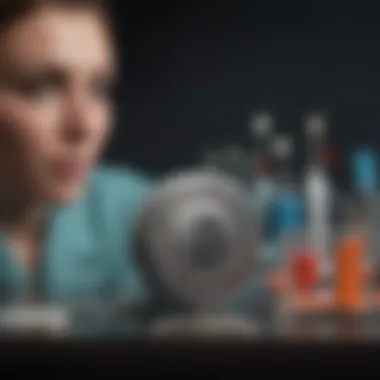Exploring the Job Market for Phlebotomists


Intro
In recent years, the field of phlebotomy has seen a substantial increase in interest. Phlebotomists play a critical role in healthcare, responsible for drawing blood and ensuring effective specimen collection. This essential job is not only about technical skill but also involves effective communication with patients. Given the demand for healthcare services, understanding the job market for phlebotomists becomes crucial for aspiring professionals.
This article aims to provide a detailed analysis of various factors influencing the phlebotomy job market. We will explore market trends, industry insights, and career pathways available for phlebotomists. The following sections will dissect how economic dynamics, technological advancements, and regional demand shape employment opportunities. By examining insights from industry professionals and salary expectations, this article will serve as a valuable guide for those looking to enter or advance in the field of phlebotomy.
Market Analysis
Current Market Trends
The job market for phlebotomists has become increasingly competitive. According to recent reports, there is a steady rise in the number of healthcare facilities, including hospitals, outpatient clinics, and diagnostic laboratories. This growth is driving the demand for qualified phlebotomists. Many healthcare organizations are recruiting phlebotomists not only to meet service demands but also to improve patient care efficiency.
Industry-specific Analysis
Phlebotomy jobs are available across various healthcare settings. Hospitals often provide the largest number of positions due to their patient volume. However, outpatient clinics and blood donation centers also offer a robust number of jobs. Additionally, advancements in technology, such as automated blood collection systems, may influence job responsibilities and availability.
Market Volatility and Risk Factors
While the job market demonstrates growth, it is not without risks. Economic fluctuations can impact healthcare funding and employment. Changes in regulations and the introduction of new technologies can create uncertainty in job security. Phlebotomists must be adaptable and willing to upskill in response to industry shifts.
Economic Insights
Economic Indicators Overview
Economic indicators like the unemployment rate and healthcare spending can provide insights into the job market. An increase in healthcare spending typically correlates with job creation in the medical sector, including phlebotomy. Monitoring these indicators can help job seekers make informed decisions about their career paths.
Global Economic Trends
Global economic conditions also affect the healthcare sector. Countries with expanding healthcare systems often show a growing need for phlebotomists. Conversely, in regions facing economic downturns, hiring may slow down or remain stagnant. Therefore, understanding global economic trends can provide context for local job opportunities.
Impact of Economic Events on Markets
Significant economic events, like recessions or pandemics, can dramatically alter job prospects. For example, the COVID-19 pandemic created an acute need for phlebotomy services, leading to increased hiring in many areas. Monitoring such events can aid phlebotomists in anticipating market changes and adapting their job search strategies accordingly.
Epilogue
In closing, aspiring phlebotomists should recognize the dynamic nature of the job market. Staying informed about trends, economic factors, and technological advancements positions candidates for success. As more healthcare facilities seek skilled professionals, understanding how to navigate this landscape becomes vital for career growth.
Overview of the Phlebotomist Role
The role of a phlebotomist is crucial in the healthcare system. Understanding this profession is vital, not just for those pursuing it as a career but also for patients and other healthcare workers. Phlebotomists specialize in drawing blood from patients for various medical tests, transfusions, or donations. They play an essential part in diagnostics and treatment planning. Knowledge about their duties and responsibilities helps clarify the significance they hold in the healthcare team.
Definition and Duties
A phlebotomist's primary function involves collecting blood samples from patients. This process must be conducted with precision and care. Their duties also encompass preparing and labeling specimens for laboratory analysis. Phlebotomists must maintain sterile techniques to avoid contamination and ensure the safety of both patients and healthcare staff.
In addition to blood collection, phlebotomists are responsible for educating patients about the procedure. This includes explaining what to expect and alleviating any concerns regarding pain or anxiety. Proper patient interaction and communication skills are necessary for building trust and rapport.
Other duties include:
- Keeping records of blood collection procedures
- Maintaining equipment and ensuring it is functioning properly
- Adhering to universal precautions and safety protocols
Importance in Healthcare
The importance of phlebotomists in healthcare cannot be understated. Effective blood collection and specimen handling are critical for accurate diagnoses. Timely blood tests can assist in identifying illnesses early, influencing treatment outcomes significantly.
Phlebotomists also free up time for doctors and nurses by handling the essential yet repetitive task of blood collection. This efficiency can improve overall workflow in medical facilities. Their role is not merely procedural; they contribute to the compassion experienced by patients during medical tests. By ensuring a smooth and professional blood draw, phlebotomists help ease the patient's experience in sometimes stressful environments.
"The phlebotomist is often the first healthcare provider a patient interacts with, making them a key player in the patient care journey."
Understanding the role and responsibilities of phlebotomists is key. It lays the groundwork for exploring the broader job market and future opportunities in this essential healthcare profession.
Current Job Market Landscape
Understanding the current job market landscape for phlebotomists is vital. It lays the groundwork for recognizing employment opportunities and the scope of the profession. As healthcare continues to evolve, phlebotomy stands out as a critical role in patient care. The data on employment statistics helps potential candidates assess the viability of entering this field and informs professionals about current market trends.
Employment Statistics
Employment statistics provide a snapshot of the phlebotomy profession's status. According to the U.S. Bureau of Labor Statistics, the employment of phlebotomists is projected to grow by 10% from 2022 to 2032. This growth rate is faster than the average for all occupations. More than 60,000 new jobs are expected to be created during this period. Such numbers reflect an increasing demand for skilled professionals in laboratory settings and healthcare facilities.
According to a recent survey, over 90% of phlebotomists reported job satisfaction. Factors contributing to this satisfaction include working in a meaningful environment and having stable employment. Moreover, data shows that around 34% of phlebotomists work in hospitals, while others find opportunities in private practices, blood donation centers, and diagnostic laboratories. This diversity in employment settings expands the options available for phlebotomists, allowing them to tailor their career paths according to their interests.
Growth Projections
The growth projections for phlebotomists highlight how advancements in healthcare influence job availability. The aging population plays a significant role in increasing demand. As the number of elderly individuals rises, the need for blood tests and routine medical care will also grow. Additionally, health trends show a focus on preventive care, which often includes regular blood work.
In addition to demographic factors, technological advancements are projected to create more roles. Innovations in medical procedures and the use of telehealth services are reshaping how phlebotomists operate. For instance, new training programs now include devices that automate blood collection processes. This shift suggests that phlebotomists will need to adapt to new technologies while retaining fundamental skills.
"The demand for phlebotomists will remain strong, given healthcare's reliance on laboratory testing and blood collection."
In summary, the employment statistics and growth projections for the phlebotomy sector paint a promising picture. This sector offers substantial opportunities for aspiring professionals, supported by favorable employment growth and evolving industry standards.
Key Factors Influencing Demand
The job market for phlebotomists is shaped by several key factors that determine the level of demand for these professionals. Understanding these elements is crucial for anyone considering a career in this field. Each factor intersects with the healthcare landscape, creating a dynamic job market that responds to societal needs.
Aging Population
One of the most significant influences on the demand for phlebotomists is the aging population. As individuals age, they typically require more frequent medical care. This demographic shift leads to a higher demand for blood tests, which phlebotomists perform. In many regions, especially in developed countries, the proportion of older adults is increasing. This creates a growing need for laboratory tests and outpatient procedures.


The U.S. Census Bureau reports that the number of people aged 65 and older will reach 95 million by 2060. This rise will likely lead to a substantial increase in healthcare services, making phlebotomists essential in supporting the diagnostics and treatment of age-related conditions.
Health Trends
Health trends also play a crucial role in the employment landscape for phlebotomists. There is a rising awareness of preventive healthcare, and routine blood tests are integral to this approach. Chronic diseases, such as diabetes and hypertension, are on the rise, emphasizing the need for regular monitoring through blood work.
Public health initiatives that promote screening programs further enhance the demand for phlebotomy services. These trends are not localized to one region; they represent global shifts in how populations approach health and wellness. Additionally, the impact of pandemics has heightened the need for testing, resulting in an increased visibility for phlebotomists in various healthcare settings.
Technological Advances
Lastly, technological advances significantly affect the demand for phlebotomists. Innovations in blood collection methods, diagnostic tools, and remote monitoring systems are transforming the way healthcare is delivered. Automation in some processes can streamline tasks, but it can also create new roles for phlebotomists who can operate sophisticated machinery and understand complex diagnostic technologies.
Telehealth services are expanding, allowing more patients to receive care without visiting a facility. This approach can increase the necessity for mobile phlebotomy services, where professionals travel to patients to collect samples. Furthermore, as technology evolves, so does the need for continuous education among phlebotomists to keep up with the latest practices and tools.
In summary, the demand for phlebotomists is not static but rather influenced by demographic changes, evolving health trends, and ongoing technological advancements. Understanding these factors provides essential insights into the job market dynamics, particularly for young professionals entering the field.
Educational Requirements
The field of phlebotomy requires a solid educational foundation to meet both regulatory standards and the expectations of employers. Understanding the educational requirements for phlebotomists is crucial for aspiring professionals as it directly correlates with job readiness and career advancement. Training programs provide the necessary skills needed to perform blood draws and ensure patient safety. Furthermore, effective education can provide individuals with a competitive edge in a crowded job market.
Certification and Training Programs
Certification in phlebotomy is often mandatory for practice in many states. Completing a formal training program is the first step toward achieving certification. Most commonly, programs are available through community colleges, vocational schools, and online education institutions. These programs typically blend classroom learning with hands-on experience.
Key components of these programs include:
- Fundamental principles of anatomy and physiology: Knowledge of the circulatory system is vital for working effectively.
- Blood collection techniques: Students learn various methods, including venipuncture and capillary collection, ensuring proficiency.
- Safety practices and infection control: These are crucial for protecting both the patient and the healthcare worker.
Graduating from an accredited program opens opportunities for obtaining certification, often from organizations such as the American Society for Clinical Pathology or the National Healthcareer Association. As a result, these certifications validate the skills and knowledge obtained during training, enhancing employment prospects significantly.
Continuing Education
Education does not stop with certification. Continuing education is essential for phlebotomists who want to stay current in practices and technologies. Many healthcare facilities expect or require their employees to participate in ongoing training. Continuing education courses often cover:
- New techniques and procedures: Phlebotomists can learn about advancements in blood collection methods.
- Regulatory updates: Keeping informed about changes to laws and best practices ensures compliance and patient safety.
Some states have specific licensure requirements that necessitate continuing education. Engaging in these programs can lead to specialization opportunities, such as working in transfusion medicine or pediatric phlebotomy.
"Continuing education helps phlebotomists keep their skills fresh and adapt to advancements in the field, ultimately enhancing patient care."
In summary, understanding and fulfilling educational requirements are fundamental steps for anyone entering the phlebotomy field. Certification and ongoing education not only prepare individuals for initial employment but also pave the way for long-term success and advancement in their careers.
Routes to Employment
The routes to employment for phlebotomists are integral to understanding how to establish a successful career in this vital healthcare role. The journey to securing a position as a phlebotomist can vary significantly based on a person's training, experience, and the specific demands of the job market at any given time. Knowing the various paths available can help aspiring professionals make informed decisions and position themselves favorably in a competitive landscape.
Employment Settings
Phlebotomists can find employment in a variety of settings, each offering unique experiences and responsibilities. Common employment settings include:
- Hospitals: These are often the primary employers for phlebotomists, providing a bustling environment where blood collection occurs frequently.
- Clinical Laboratories: These labs focus exclusively on testing and analysis, and phlebotomists here may work closely with healthcare providers to facilitate diagnostic testing.
- Blood Donation Centers: Organizations like the American Red Cross rely on phlebotomists to collect blood from donors, ensuring a steady supply for patients in need.
- Physician's Offices: Smaller medical practices may require on-site blood draws. Phlebotomists in these settings often build strong relationships with patients.
- Long-Term Care Facilities: Nursing homes and assisted living centers may employ phlebotomists to handle routine blood draws for residents.
Each setting presents different challenges and benefits. For instance, hospitals may offer more dynamic experiences while private practices often provide a more personal touch to patient interactions. Choosing the right environment can lead to greater job satisfaction and career growth.
Applying for Positions
Navigating the application process for phlebotomy roles requires strategic planning and attention to detail. Potential candidates should consider the following key approaches:
- Tailoring Your Resume: Highlight relevant certifications and practical experiences. Use keywords like "phlebotomy training" or "blood collection techniques" to catch the attention of employers.
- Networking: Building a professional network can open doors. Attend workshops, conferences, or join online forums on platforms like Reddit to connect with others in the field.
- Preparing for Interviews: Anticipate common interview questions related to patient interactions and difficult blood draws. Demonstrating both technical competence and interpersonal skills is essential.
- Utilizing Job Boards: Websites such as Indeed or Monster can be useful for finding open positions. Consider also seeking roles on specialized healthcare job platforms.
- Following Up: After an interview, send a brief thank-you note. This reflects professionalism and reinforces your interest in the position.
"A proactive approach not only enhances your visibility to employers but also elevates your professionalism in the eyes of potential coworkers."
In summary, understanding the routes to employment is crucial for phlebotomists. Recognizing the various environments where they can work and mastering the application process can lead to effective job searching and career fulfillment.
Career Advancement Opportunities
The field of phlebotomy is not only vital for healthcare but also offers various pathways for career advancement. As the healthcare industry continues to grow, phlebotomists have a unique opportunity to expand their skills and take on more complex roles. Career advancement is essential for personal fulfillment and professional growth. Here, we will explore specialization options and leadership roles available to phlebotomists that can further develop their careers.
Specialization Options
Phlebotomists can enhance their careers through specialization. Specializations can make one more competitive and provide opportunities for higher pay. Several areas for specialization include:
- Donor Phlebotomy: Focusing on blood donation, this specialization requires knowledge of donor health and safety. Training can lead to roles in organizations like the American Red Cross.
- Clinical Pathology: Phlebotomists can work closely with laboratory technicians, understanding lab procedures and testing protocols. This role allows one to become an integral part of patient diagnostics.
- Pediatric Phlebotomy: Specializing in blood draws from children requires a unique set of skills. Phlebotomists focusing on pediatrics must be adept at creating a comforting environment for young patients.
Specialization may require additional certification, such as the Certified Specialist in Phlebotomy (CSP) credential. These credentials not only signify expertise but also boost one's marketability in the job market.
Leadership Roles
Those looking to move beyond technical roles may consider leadership opportunities. With experience, phlebotomists can advance to supervisory or managerial positions. Leadership roles may include:
- Lead Phlebotomist: In this position, one oversees a team of phlebotomists, ensuring quality of care and adherence to protocols. Lead phlebotomists also train new staff and handle more complex situations.
- Phlebotomy Program Director: Those with extensive experience might even oversee phlebotomy training programs. This role involves curriculum development and ensuring programs meet certification standards.
- Quality Assurance Officer: Focusing on compliance and standards, this role ensures that all procedures comply with health regulations and best practices. Quality assurance officers play a critical role in maintaining the integrity of healthcare facilities.
Advancement into leadership not only involves acquiring new skills but also developing soft skills such as communication and conflict resolution. Taking courses in management can prepare phlebotomists for such responsibilities.
"Investing in one's education and skills is crucial for anyone looking to advance their career in phlebotomy."
Salary Expectations
Understanding salary expectations for phlebotomists is vital for various reasons. First, it allows prospective professionals to align their career choices with realistic financial goals. Often, salary figures can influence decisions on education, training, and specialization. Moreover, knowing salary ranges can help in negotiations during the hiring process. A well-informed candidate can advocate for themselves better, reflecting their skills and experience without underestimating their worth.
Average Salaries by Region


Salary for phlebotomists varies significantly based on geographic location. Major urban centers often offer higher salaries compared to rural areas due to cost of living and demand for healthcare services. For instance, large cities such as New York and San Francisco tend to provide higher compensation rates, sometimes exceeding $50,000 annually. On the other hand, rural regions may see averages as low as $30,000.
The following list outlines average annual salaries for phlebotomists across different regions based on recent data:
- Northeast: $45,000 - $55,000
- Southeast: $33,000 - $40,000
- Midwest: $35,000 - $42,000
- Southwest: $40,000 - $48,000
- West Coast: $48,000 - $60,000
Such variations indicate that aspiring phlebotomists should consider both the potential salary and the cost of living in their preferred regions. Emphasis on regional pay disparities is crucial for making informed decisions about relocation as part of their job search.
Factors Affecting Salary
Several factors play a crucial role in determining the salary of a phlebotomist. These include:
- Experience Level: More experienced phlebotomists typically command higher salaries. Entry-level positions may start at lower rates while seasoned professionals earn significantly more.
- Certifications: Holding additional certifications, such as those offered by The American Society for Clinical Pathology, can enhance employability and salary potential. Employers often value these credentials and may offer higher compensation for certified individuals.
- Work Setting: The environment in which a phlebotomist operates influences earnings. Positions in hospitals or specialized medical facilities tend to pay better than those in outpatient clinics or labs.
- Demand and Supply: Job demand in a particular region directly impacts salaries. Areas with a shortage of skilled phlebotomists usually offer higher pay to attract qualified candidates.
A comprehensive understanding of these factors can empower professionals in their career advancement decisions. In summary, the salary landscape for phlebotomists is complex and subject to various influences, requiring careful consideration before choosing a career path.
Regional Variations in Employment
Understanding the regional variations in employment for phlebotomists is critical for both aspiring professionals and established workers in the field. Locations across the United States show notable differences in job demand, salary levels, and workplace conditions. This analysis can inform decisions concerning education, relocation, and career development.
Phlebotomists may find more opportunities in urban areas where healthcare facilities tend to be more concentrated. Cities often have a larger population, leading to higher patient volumes that require blood collection. Region-specific needs can also arise from local health trends, such as the prevalence of certain diseases that require frequent blood testing. Therefore, knowing where demand is highest can help job seekers target their applications more effectively.
Another crucial consideration is the cost of living in different areas. While some regions may offer higher salaries, they might also have higher expenses. This fact can influence overall job satisfaction and work-life balance. For instance, a phlebotomist in San Francisco may earn more compared to their counterpart in a smaller city, but their take-home pay could be significantly affected by living costs in the Bay Area.
"Location matters. Researching job markets can significantly improve your chances of finding well-suited opportunities."
Overall, regional knowledge aids in making informed decisions regarding job placements, salary negotiations, and future career planning.
High Demand Areas
Certain regions stand out as high demand areas for phlebotomists. Cities like Los Angeles, New York, and Houston exhibit a robust need for skilled phlebotomists, fueled by their vast healthcare systems. These metropolitan areas not only have a variety of hospitals and clinics but also a growing population that contributes to rising healthcare demands.
In addition, states such as Florida and Texas are experiencing significant growth in healthcare services, which directly influences the number of jobs available. To improve employment prospects, candidates should consider opportunities in these high-demand locations. Here are some notable aspects:
- Competitive Salaries: High demand often leads to higher wages, giving practitioners better financial incentives.
- Variety of Employment Settings: Opportunities exist in hospitals, outpatient clinics, and specialized laboratories offering diverse work environments.
- Career Growth: High demand regions often provide more avenues for advancement and specialization within the field.
Emerging Job Markets
Emerging job markets for phlebotomists are increasingly present in suburban and rural areas. As healthcare initiatives expand, more facilities are opening in previously underserved locations. For instance, telehealth expansions can lead to demand for on-site blood collection services even in smaller towns. Emerging markets also include innovative healthcare services such as home healthcare, where phlebotomists are needed to perform blood draws in patients' homes.
Key trends contributing to these markets include:
- Rural Healthcare Initiatives: Government programs focusing on improving healthcare delivery in rural areas.
- Mobile Health Clinics: These clinics are gaining popularity, providing service to various communities and needing phlebotomy services.
- Integration of Technology: With advancements in medical tech, new roles within phlebotomy that blend technological expertise and traditional skills are emerging.
Essential Skills for Phlebotomists
In the ever-evolving landscape of healthcare, phlebotomists play a crucial role, often being the first point of contact in laboratories or healthcare facilities. This section highlights the essential skills required for phlebotomists, dividing them into two main categories: technical skills and interpersonal skills. Both sets of skills are critical to achieving accuracy and maintaining patient trust in the blood collection process.
Technical Skills
Technical skills are fundamental for phlebotomists. Mastery of these skills ensures that blood collection is efficient, safe, and consistent. Key technical skills include:
- Blood Collection Techniques: Phlebotomists must be adept at various methods for blood draw, including venipuncture and capillary collection. Proficiency in these techniques reduces discomfort for patients and increases sample integrity.
- Use of Medical Equipment: Familiarity with needles, vacutainers, and other medical devices is essential. Knowing how to select the appropriate equipment for different situations minimizes complications.
- Sample Handling: Proper processing of blood samples is vital to avoid contamination and ensure valid test results. This involves understanding how to label, store, and transport specimens correctly.
- Infection Control Practices: Adhering to strict hygiene and safety protocols protects both the phlebotomist and the patient. This includes understanding universal precautions and using personal protective equipment.
"Technical proficiency not only contributes to patient safety but also enhances the credibility of the healthcare facility."
Each of these technical skills contributes to the overall effectiveness of a phlebotomist’s role, allowing them to work efficiently in high-pressure environments often encountered in healthcare settings.
Interpersonal Skills
While technical skills are vital, interpersonal skills also play an equally important role in the success of a phlebotomist's career. These skills are essential for building rapport with patients and ensuring a smooth blood collection experience. Some key interpersonal skills include:
- Communication: Clear and compassionate communication with patients helps ease anxiety. Phlebotomists must explain procedures simply and answer questions effectively, which can contribute significantly to patient comfort.
- Empathy: Understanding the feelings and concerns of patients is crucial. Demonstrating empathy can help establish trust, making patients feel more at ease during their visit.
- Adaptability: Each patient and situation is unique. Phlebotomists need to adapt their approach based on individual patient needs, behaviors, and health conditions.
- Conflict Resolution: Occasionally, situations may arise where patients are difficult. Strong conflict resolution skills enable phlebotomists to navigate these challenges calmly and professionally.
In summary, both technical and interpersonal skills are vital for phlebotomists. Excellence in these areas not only enhances job performance but also enriches the patient experience. As the healthcare environment continues to evolve, the demand for skilled phlebotomists who can balance technical expertise with personal interaction will likely continue to grow.
Challenges in the Job Market
The job market for phlebotomists is not without its difficulties. Understanding these challenges is essential for anyone looking to enter this field or advance their career.
Competition for Positions
One of the significant hurdles in the phlebotomy job market is the competition for available positions. With the growing number of training programs across the country, more candidates are entering the field each year. This influx can saturate the market, making it difficult for new graduates to secure positions.
Job seekers often find themselves competing with individuals who have more experience or additional certifications. Many healthcare facilities prioritize candidates who have a well-rounded skill set. Thus, aspiring phlebotomists should consider gaining practical experience through internships or volunteer work. This can help them stand out in a crowded applicant pool. Networking can also play a crucial role in this landscape, allowing candidates to connect with industry professionals who may offer job leads or mentorship.
Job Security and Stability
Job security is another concern for many phlebotomists. While the demand for blood testing remains stable, various factors can contribute to insecurity in employment. For instance, fluctuations in healthcare funding or technological advancements that automate certain processes can impact staffing levels in laboratories and clinics.
Moreover, the recent shift towards telehealth services has introduced new dynamics in patient care. As more healthcare providers adopt virtual consultations, the traditional roles of phlebotomists may evolve. This means that phlebotomists must remain adaptable and willing to learn new technologies or practices to maintain their relevance in the field. Continuous education and skill enhancement will be vital for long-term job security.
"Adapting to changes in the healthcare environment is critical for maintaining job stability in phlebotomy."
In summary, while there are notable challenges in the job market for phlebotomists, understanding these issues can better prepare candidates for the journey ahead. Continuous professional development and strategic networking will help aspiring phlebotomists navigate this competitive landscape.
Technological Impact on Phlebotomy
The technological advancements in the field of phlebotomy play a crucial role in how blood collection and related healthcare services are performed. With an ongoing shift towards efficiency and precision, understanding these technologies becomes essential for both new entrants and experienced professionals in the job market. This section outlines two significant areas of technological impact: automation in blood collection and the rise of telehealth services. Both areas reshape the landscape of phlebotomy.


Automation in Blood Collection
Automation has increasingly influenced blood collection processes. Various devices designed to enhance efficiency are now integrated into laboratories and clinics. Automated blood collection systems allow for a more systematic approach that can reduce human error.
These systems have several benefits:
- Increased Efficiency: Automated systems can handle multiple samples simultaneously, significantly reducing the time required for blood collection.
- Enhanced Accuracy: Reducing human oversight also means fewer mistakes in sample handling, leading to more reliable results.
- Improved Patient Experience: Automated devices can minimize discomfort during blood draws by utilizing advanced technology that requires less manipulation.
However, there are considerations. While automation improves efficiency, it does not completely replace the need for skilled phlebotomists. Professionals must still monitor devices and interact with patients.
Furthermore, those working in this field must be proficient with these technologies to understand their operation and troubleshoot potential issues. Thus, continuous training is imperative.
Telehealth and Remote Services
The growth of telehealth services has been accelerated by technological advancements. Patients can receive care remotely, which expands access to necessary healthcare services.
Key benefits include:
- Accessibility: Patients who may struggle to visit a clinic can connect with phlebotomists through telehealth, ensuring they receive their essential blood tests.
- Convenience: Telehealth services offer flexibility for patients to schedule their blood draws at their convenience, often in their own homes.
- Cost-Effectiveness: Remote services can reduce overall healthcare costs by minimizing travel and waiting times.
As the demand for telehealth services rises, phlebotomists are expected to adapt. Knowledge of remote patient interactions and working with mobile blood services will become increasingly important.
"The integration of technology in phlebotomy signifies a transformation that balances efficiency with patient care."
Networking and Professional Development
Networking and professional development are critical components in advancing a career in phlebotomy. These aspects not only enhance the visibility of professionals in the field but also provide valuable resources that can significantly impact job prospects and career growth. In a competitive job market, having a strong network can lead to opportunities that might not be accessible through traditional job searching methods.
Joining Professional Organizations
Becoming a member of professional organizations such as the American Society for Clinical Pathology or the National Phlebotomy Association can be beneficial in many ways. These organizations offer a range of resources, including continuing education, certifications, and access to job boards specifically tailored to phlebotomists. Members often gain insights into best practices and industry standards, which can enhance their skills and make them more marketable to employers.
Moreover, joining these organizations can facilitate connections with seasoned professionals and mentors in the field. This networking can prove invaluable for young phlebotomists looking to navigate the early stages of their careers. Members may also receive newsletters or publications that keep them updated on new developments, trends, and job postings.
Attending Industry Conferences
Industry conferences provide another excellent opportunity for phlebotomists to build professional connections. These events showcase advancements in technology, techniques, and regulations impacting phlebotomy. Participants can attend workshops and seminars, expanding their knowledge base and gaining practical skills that enhance their employability.
Additionally, conferences allow for direct interaction with potential employers, allowing job seekers to get a foot in the door. They can also be a platform for sharing experiences and strategies with peers facing similar challenges in the job market. Building relationships during these events can lead to job referrals, collaborations, and mentorship opportunities.
In a field where continuous learning is essential, engaging in networking and professional development activities can set a phlebotomist apart in a crowded job market. By actively participating in professional organizations and attending industry conferences, individuals not only improve their skills but also increase their chances for career advancement.
Insights from Industry Professionals
Understanding the perspectives of those currently working in the phlebotomy field provides valuable insights for aspiring professionals. Industry professionals have firsthand experience with the demands, challenges, and rewards associated with the role of a phlebotomist. They can shed light on the nuances of the job market, including the expectations of employers and the skills that set candidates apart. This section explores how these insights can inform career decisions and advancement strategies.
Interviews with Phlebotomists
Interviews with practicing phlebotomists reveal critical information about the realities of the job. These discussions often cover a range of topics, including daily responsibilities, interactions with patients, and the emotional aspects of the job. Phlebotomists emphasize the importance of maintaining composure during their duties, as they frequently deal with anxious patients.
Moreover, many mention that ongoing training and adaptability to new technologies are essential. With advancements in blood collection and testing methods, a commitment to continual learning is a common theme among industry professionals.
Furthermore, many phlebotomists reflect on their career paths, detailing how they transitioned from education programs to securing fulfilling employment. Learning from their stories helps prospective phlebotomists identify potential pathways and mentors within their networks.
Tips for Aspiring Phlebotomists
Aspiring phlebotomists should consider several key recommendations from seasoned professionals:
- Networking is Crucial: Building connections within the healthcare field can open doors to job opportunities. Attend local healthcare events and engage with professionals on platforms such as LinkedIn.
- Pursue Relevant Certifications: Obtaining certifications from recognized bodies like the National Phlebotomy Association can significantly enhance a resume. These certifications demonstrate a commitment to excellence in the field.
- Develop Strong Interpersonal Skills: As phlebotomists interact with diverse patients, effective communication skills are vital. This ensures not only a smooth procedure but also helps in building trust with patients.
- Stay Updated on Industry Trends: Follow developments in healthcare and phlebotomy to maintain a competitive edge. Knowledge of emerging technologies is increasingly valuable in the job market.
- Seek mentorship: Find a mentor who can provide guidance and career advice. Having someone experienced to consult can be invaluable as you navigate your own professional journey.
"The insights gained from those already in the field are instrumental in shaping knowledge and improving employability and success in phlebotomy."
Future Trends in Phlebotomy Careers
Understanding the future trends in phlebotomy careers is essential for both those entering the field and for seasoned professionals. With the healthcare landscape continuously evolving, phlebotomists must adapt to changes that affect their roles, responsibilities, and the skills required to succeed. Several factors drive these changes, including advancements in technology, shifts in patient care delivery, and evolving healthcare policies.
Evolving Job Roles
As the healthcare industry adapts to new challenges, the role of the phlebotomist is also changing. Traditionally, phlebotomists focused primarily on blood collection. However, today they are expected to engage in a wider range of tasks. For instance, phlebotomists may now be involved in patient education, specimen processing, and data management. These expanded responsibilities require phlebotomists to develop additional skills beyond traditional venipuncture.
Furthermore, specialized areas within phlebotomy are gaining traction. For example, phlebotomists may work specifically with pediatrics or geriatrics, requiring unique approaches to patient interaction and care. In addition, telehealth is beginning to influence the phlebotomy field, with remote services that include virtual consultations and guidance on blood sample collection.
"The phlebotomy role is transforming. The future demands more than just technical skill; it requires adaptability and broader competencies."
Impact of Healthcare Reforms
Healthcare reforms play a critical role in shaping the future of phlebotomy. Policies designed to improve patient access to care directly influence how phlebotomists operate. With more emphasis on preventative care and patient-centered approaches, phlebotomists may find themselves in roles that emphasize outreach and education.
Reforms have also led to the integration of electronic health records (EHR) systems, which streamline processes for healthcare providers. Phlebotomists must become proficient in navigating these systems to ensure accurate data entry and improve patient safety. As healthcare reforms continue, it is crucial for phlebotomists to stay informed and adapt to new workflows that arise from these policies.
Phlebotomists preparing for the future should also consider gaining certifications that are recognized in the changing regulatory environment. This proactive approach can enhance job security and open new career avenues.
Culmination
The conclusion of this article serves a vital role in summarizing the journey through the phlebotomy job market. It reflects on the major themes presented throughout the text and emphasizes the significance of understanding the factors at play in this field. By examining the evolution of the phlebotomy profession, one can identify opportunities and challenges that exist for current and aspiring phlebotomists. The importance of a well-rounded education, networking, and remaining informed about industry trends cannot be overstated.
From the perspectives shared by experienced professionals, to the analysis of technological influences, each element provides clarity on how individuals can enhance their careers in phlebotomy. Job security and opportunities for career advancement are essential aspects that will continue to evolve as the healthcare landscape changes.
The insights into salary expectations and regional variations help individuals make informed decisions about their career paths. Ultimately, this section pulls together the essential points made throughout the article, urging readers to reflect on their personal career journeys in the context of these insights.
Recap of Key Points
- Phlebotomists play a crucial role in healthcare, affecting patient outcomes.
- Understanding employment statistics and growth projections can guide career choices.
- Knowledge of essential skills, both technical and interpersonal, is fundamental.
- Regional employment variations impact job availability and salaries.
- Networking and continuous education significantly influence professional growth.
- Technology is reshaping the job landscape, making adaptability necessary for future success.
Final Thoughts on the Future
The future of phlebotomy careers appears promising, driven by an aging population and an increased emphasis on healthcare providers. The demand for skilled phlebotomists will likely grow as more specialized services emerge. Aspirants must remain adaptable, focusing on ongoing education and honing relevant skills. Additionally, as telehealth expands, new roles may arise. This will challenge phlebotomists to embrace innovation while maintaining core competencies. Those who position themselves strategically are likely to find success and fulfillment in this essential health sector.















